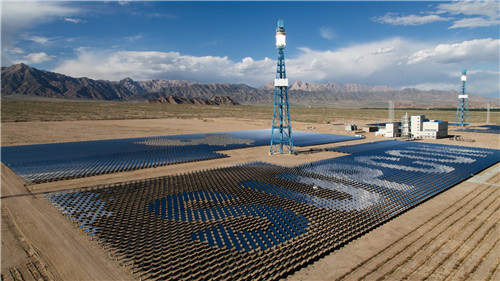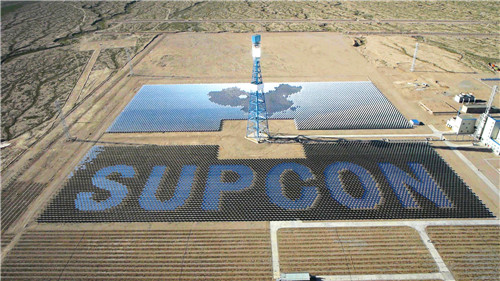How can science be translated into technology and then benefit society? How do scientists work with stakeholders such as industry? These questions occassionally bother scientists who are known for sitting in the "Ivory Tower".
Ph. D student ZHANG Yue from Institute of Atmospheric Physics, got a chance to think about the answers when he and his supervisor Prof./ Academician SHI Guangyu visited SUPCON 50MW Tower Plant located in Delingha, Qinghai province on September 15.
Delingha SUPCON 50MW Tower Plant is the first commercialized CSP (Concentrating Solar Power) station in China. Since the first 10 MW phase of the project was connected to electricity grid in July 2013, it has been operated smoothly and steadily. "Once the whole project is completed, annual generation production can reach 120 million kWh which can supply clean energy for more than 80 thousand households." Mr. LIU Wenchuang, deputy general manager at Qinghai SUPCON Solar Technology Co., Ltd., introduced, " Moreover it can save 42.4 thousand tons of standard coal and reduce emission of 110 thousand tons of CO2. "


Panorama view of the CSP station in Qinghai (Photos provided by Zhejiang SUPCON Solar Technology Co., Ltd.)
Different from PV (Photovoltaic) station, the CSP station only uses DNI (Direct Normal Irradiance) rather than GHI (Global Horizontal Irradiance). At a CSP station, solar collectors can concentrate DNI to receiver through sun tracker, and then the radiation is converted to heat. With heat exchanger and steam turbine generator, heat energy eventually becomes electricity. If CSP is combined with thermal energy storage, the power plant would be able to produce electricity day and night without intermittence. The stability of a CSP project is an important advantage compared to PV station. Until December 31, 2014, total capacity of operating CSP projects in China is about 18MW. Except for the first 10MW phase of Delingha SUPCON Tower Plant, the remaining 8MW are small-scale experimental projects.
National Development and Reform Commission had approved the establishment of a renewable energy demonstration zone on July 28, 2015 in Zhangjiakou city, where 2022 Winter Olympics will be held. According to the plan, renewable energy capacity in Zhangjiakou will reach 20GW in 2020, and in 2030, it will be 50GW. Correspondingly, the planned capacity of CSP projects will be 1GW (1GW=1000MW) and 6GW respectively. Therefore, both renewable energy demonstration zone and Winter Olympics will promote the development of CSP industry during 13th Five Year (2016-2020).
Yue was fascinated by the blueprint of CSP industry and discussed with power plant staff on what IAP can help in improving solar resource assessment as well as solar power integration. Prof. SHI's group has been working on short-term DNI forecasting. "Forecasting DNI accurately in distinct time horizons is significant to both grid dispatching center and power plant operator. " Yue explained, "However, the derivation of DNI is not straightforward. Unlike GHI, this parameter is not an output of state-of-the-art numerical weather prediction model. Moreover, DNI is more sensitive to aerosols in clear sky and this influence becomes severe considering the presence of cloud. " Mentored by Prof. SHI, Yue is developing a DNI ensemble forecasting methodology which will improve model performance under different atmospheric turbidity.
The power plant staff wanted to be posted of the research progress and they wished that the IAP research results can be first applied to CSP projects of SUPCON in Qinghai and other regions. ZHANG recalled excitedly after the visit, "It's highly rewarding to know our research results can be immediately used and what we do is useful to the society."
